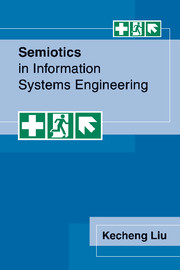Book contents
- Frontmatter
- Contents
- Preface
- 1 Introduction
- Part one Semiotic framework and methods
- Part two Applications
- 9 From semiotic analysis to systems design
- 10 Semantic temporal databases
- 11 Normbase: a new approach to information management
- 12 Case study: development of a land resources information system
- 13 Case study: development of a test construction system
- Appendix A Semantic templates and surrogate specification
- Appendix B LEGOL applications in the CRIS case
- Bibliography
- Index
9 - From semiotic analysis to systems design
Published online by Cambridge University Press: 19 September 2009
- Frontmatter
- Contents
- Preface
- 1 Introduction
- Part one Semiotic framework and methods
- Part two Applications
- 9 From semiotic analysis to systems design
- 10 Semantic temporal databases
- 11 Normbase: a new approach to information management
- 12 Case study: development of a land resources information system
- 13 Case study: development of a test construction system
- Appendix A Semantic templates and surrogate specification
- Appendix B LEGOL applications in the CRIS case
- Bibliography
- Index
Summary
If the objective of a system analysis is to understand and specify the users' requirements, then the next objective is to produce a design of a computer information system. The core of a computer information system comprises a database and other application programs. This chapter will address the semantic aspect of the computer information systems, and discuss the relationship between semantic models and database design.
The semantic aspect of databases
Data and code in a database are meaningless until someone assigns a meaning to them and someone is able to interpret them. The meaning of data is rooted in social and cultural conventions and norms. The assignment of meaning to the data and interpretation of the data have to follow the same social and cultural norms. The interpretation is a complex, creative act that relies on personal knowledge and understanding of the norms. A successful use of data and derivation of information meaningful to a user is a key issue in databases. This issue cannot be resolved by technical means alone but requires social and organisational arrangements.
There can be two kinds of meanings distinguished: intension (sense) and extension (or reference). These two notions can be applied to predicates, propositions and sentences. The intension of a predicate, i.e. its sense, is identified with the property it expresses; its extension is the generalised class of referents in the world of affairs that possess the property. The intension of a proposition is determined by the meanings of the predicates used; the extension is its correspondence to the world of affairs.
- Type
- Chapter
- Information
- Semiotics in Information Systems Engineering , pp. 119 - 132Publisher: Cambridge University PressPrint publication year: 2000



